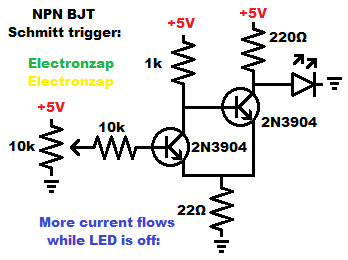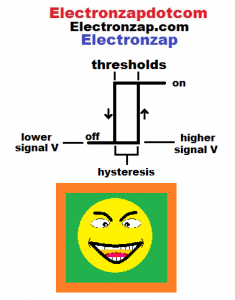Table of Contents

Schmitt triggers don’t have a single input voltage where they switch output states.
For a non inverting output…
You have to raise the input voltage to a certain point (upper threshold) to change the output state from low to high. Whereas you need to lower the input voltage to a lower voltage (lower threshold), to switch the output from high to low.
There is a middle ground voltage range (hysteresis) where the output stays in whatever state it was last put in to. The output won’t keep switching if the voltage keeps bouncing around between those 2 voltages as long as it stays well between them.

The NPN bipolar junction transistor (BJT) Schmitt trigger turns on and off suddenly when the input voltage passes through each of the 2 threshold voltages. Whereas a lone NPN BJT wired as a switch will fade on as the input voltage slowly rises above about 0.6V, and will fade off as the input voltage slowly lowers below approx. 0.6V.
Video:
To support this site, check out the following links:
- Become a Patron!
- Check out my YouTube videos! https://www.youtube.com/c/Electronzap/videos
- Products I used in my videos or otherwise think look like a good buy. As an Amazon associate, I earn from qualifying purchases. https://www.amazon.com/shop/electronzapdotcom
- Information on this site is not guaranteed to be accurate. Always consult the manufacturer info/datasheet of parts you use. Research the proper safety precautions for everything you do.
- Electronzap is a participant in the Amazon Services LLC Associates Program, an affiliate advertising program designed to provide a means for sites to earn advertising fees by advertising and linking to amazon.com.